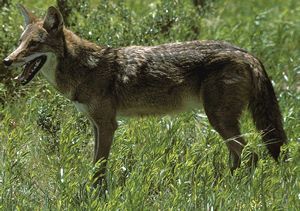No, not another sports team. A bit of wildlife that has found a home in the big city.
As the Houston region continues to develop over the next few years, wildlife removal experts say that interactions between coyotes and humans will steadily increase until their encounters are a more common occurrence.
Coyote sightings in Houston used to be rare and could be the subject of viral moments, like the video last year of a coyote scaling a fence and roof in a Richmond backyard.
Mark Browning from Houston’s Elite Wildlife Services said that years ago coyotes would normally only be seen on the outskirts of undeveloped properties. But as more areas get developed, there has been an uptick in calls for coyote removal services in more urbanized zones.
For instance, a few weeks ago Browning said that his company received a call about a coyote on the top floor of a downtown parking garage, calling the ordeal a “spectacle” with people afraid the coyote was going to bite someone. There were also recent reports of coyote sightings near Memorial Park in Houston.
“They are absolutely increasing, and they’ve become very urbanized,” Browning said. “They learn our habits, like when we take our trash out. And they really don’t have any natural enemies so there’s really nothing to control the population.”
Brad Gurrerra from Quality Pest & Wildlife also says he’s been hearing a lot more concerns from residents living in the Heights and the Woodlands about coyote sightings.
“Even myself, I’ve had two outdoor cats that have been killed by a coyote,” Gurrerra said. “And we live in a suburban neighborhood. They’re pretty much everywhere.”
[…]
The Humane Society recommends hazing to attempt to change coyote behavior, such as yelling and waving your arms while approaching coyotes and using noisemakers, projectiles and other repellents to attempt to keep coyotes afraid of humans. TPW also urges people to not feed coyotes, keep pet food and water inside, secure garbage and compost piles, keep fruit trees fenced or pick up fallen fruit and not feed feral cats that coyotes can prey upon.
You can click on the embedded image to go to the Texas Parks and Wildlife page on coyotes. While your odds of encountering one of these critters has increased as the urban landscape has overtaken their original habitat, they’re not likely to be much bother. As a smug urban elitist I would of course prefer to not have to think about wildlife at all, but this is the world we live in now. Learn to cohabitate, our space is going to get more crowded as we go forward.


“Even myself, I’ve had two outdoor cats that have been killed by a coyote,” Gurrerra said. “And we live in a suburban neighborhood. They’re pretty much everywhere.”
What exactly would be the definition of ‘everywhere’ ? ‘Everywhere’ is where coyotes have been systematically snacking on the feral cat population ? Far as I’m concerned, that’s a win-win.
Where I live, there is a small gully with a stream that runs into White Oak Bayou, and there are several coyotes that live somewhere in that gully. I see them quite often of an evening, or very early morning, sometimes gamboling around and other times resting on the grass across the street. This is inside the Loop.
These coyotes run from any human, and from the barking of my dogs. They are not a threat. And coyotes are very unlikely to bother an adult human. They are not that big, ranging from 25 to 55 lbs, most of them probably around 30 or 35 lb.
No doubt human activity brings more coyotes. First, by eliminating larger predators like wolves or bears, which would cause any coyote on the territory to be under the radar, as larger predators would either prey on the smaller predators or run them off good hunting grounds. Second, people litter and leave trash cans open, which coyotes are scavengers that will eat scraps. As well, the trash brings mice and rats and roaches, which coyotes will eat.